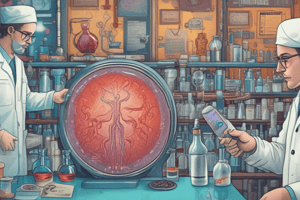Podcast
Questions and Answers
What is the most frequently analyzed non-blood body fluid?
What is the most frequently analyzed non-blood body fluid?
- Throat swab
- Urine (correct)
- Semen
- Bone marrow aspirate
Which type of specimen involves the collection and pooling of all urine voided in 24 hours?
Which type of specimen involves the collection and pooling of all urine voided in 24 hours?
- 24-hour urine (correct)
- Timed urine
- Random urine
- Fasting urine
Who typically handles inpatient urine collections?
Who typically handles inpatient urine collections?
- Patients themselves
- Nursing personnel (correct)
- MLTs
- Phlebotomists
Which specimen type is commonly used for glucose tolerance testing, collected 2 hours after a meal?
Which specimen type is commonly used for glucose tolerance testing, collected 2 hours after a meal?
Why should labels be applied to the container of a specimen instead of the lid?
Why should labels be applied to the container of a specimen instead of the lid?
Which body substance is commonly used to monitor wellness, diagnose urinary tract infections, and detect metabolic diseases?
Which body substance is commonly used to monitor wellness, diagnose urinary tract infections, and detect metabolic diseases?
What is the purpose of collecting urine specimens?
What is the purpose of collecting urine specimens?
Which type of urine specimen is commonly used for glucose tolerance testing?
Which type of urine specimen is commonly used for glucose tolerance testing?
Why should labels on urine specimens be applied to the container instead of the lid?
Why should labels on urine specimens be applied to the container instead of the lid?
What is the importance of the timeliness of testing urine specimens?
What is the importance of the timeliness of testing urine specimens?
Which type of urine specimen involves collecting and pooling all urine voided in 24 hours?
Which type of urine specimen involves collecting and pooling all urine voided in 24 hours?
Who typically handles outpatient urine collections?
Who typically handles outpatient urine collections?
Flashcards are hidden until you start studying
Study Notes
Urine Specimens
- Urine is the most frequently analyzed non-blood body fluid.
- A 24-hour urine specimen involves collecting and pooling all urine voided in 24 hours.
- Inpatient urine collections are typically handled by nurses or other healthcare professionals.
- A 2-hour postprandial urine specimen is commonly used for glucose tolerance testing, collected 2 hours after a meal.
- Labels should be applied to the container of a specimen instead of the lid to ensure proper identification and to prevent label loss.
- Urine is commonly used to monitor wellness, diagnose urinary tract infections, and detect metabolic diseases.
- The purpose of collecting urine specimens is to aid in diagnosis, monitor health, and detect diseases.
- A 2-hour postprandial urine specimen is commonly used for glucose tolerance testing.
- Labels on urine specimens should be applied to the container instead of the lid to ensure proper identification and to prevent label loss.
- Timely testing of urine specimens is important to ensure accurate results and to facilitate prompt diagnosis and treatment.
- A 24-hour urine specimen involves collecting and pooling all urine voided in 24 hours.
- Outpatient urine collections are typically handled by patients themselves or by laboratory personnel.
Studying That Suits You
Use AI to generate personalized quizzes and flashcards to suit your learning preferences.



